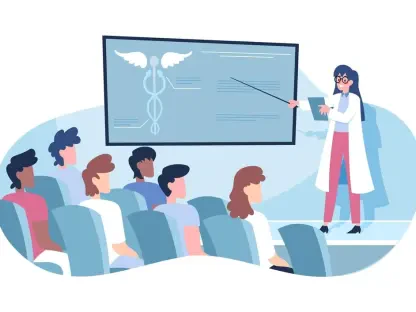The J.P. Morgan Healthcare Conference held every January at the Westin St. Francis in San Francisco marks a critical event for the healthcare industry. This conference draws biopharma and health system executives, investors, reporters, and a myriad of stakeholders. It acts as a forum to examine financial performances, deliberate on strategic moves, introduce technological innovations, and tackle pivotal issues like women’s health.
Financial Performances and Strategic Shifts
Health Systems’ Financial Recovery
In 2024, there was a significant resurgence in the financial health of many systems. The resurgence was underpinned by notable improvements in outpatient revenue, operating margins, and the reduction in patient stay durations. These key metrics contributed to creating a more stable financial landscape compared to the prior year. During the conference, executives took the stage to share their strategies and insights gleaned from their successful navigation of these financial upturns. They discussed the impact of operational adjustments, strategic investments, and the broader economic factors influencing them.
Leaders spoke about how innovative care models and improved operational efficiencies have aided in reducing costs and improving patient outcomes. The conversations underscored the significance of technology and data analytics in steering these positive changes. Health system executives were keen on highlighting their forward-looking strategies aimed at bolstering financial sustainability amid an evolving healthcare environment, reflecting an optimistic yet cautious outlook for the year ahead.
Challenges Faced by Baxter International
Baxter International was among the early participants of the conference, drawing attention to its recovery efforts following the devastation caused by Hurricane Helene. The hurricane had severely impacted one of their key manufacturing facilities in North Carolina, leading to a significant disruption in their operational capabilities. Baxter’s representatives shared insights on the strategic shifts and recovery initiatives currently underway to mitigate such disruptions in the foreseeable future.
The company elaborated on their contingency planning, emphasizing the investment in infrastructure resilience and adaptive supply chain strategies. This discussion brought to light the broader industry challenges of addressing natural disasters and their unforeseen impacts on healthcare operations. Baxter’s approach highlighted the need for robust disaster preparedness and multi-level contingency frameworks to ensure minimal interruptions in essential medical supplies. As they detailed their progress and anticipated challenges, it became evident that such strategic shifts are crucial for sustaining and future-proofing operations in a volatile global environment.
Key Participating and Non-Participating Entities
Notable Health Systems
The conference brought together over 500 public and private healthcare and life sciences companies, showcasing a diverse array of perspectives and innovations. Among the prominent attendees were notable health systems like Ascension, AdventHealth, Intermountain Healthcare, Providence, CommonSpirit Health, Mayo Clinic, and Johns Hopkins. These leading institutions shared their latest developments and strategic plans for the coming year. The discussions ranged from advancements in clinical care and patient engagement to the integration of cutting-edge technologies in healthcare delivery.
The presence of such influential players underscored the importance of collaborative efforts in driving forward the healthcare agenda. The exchange of knowledge and experiences facilitated by this conference played a crucial role in shaping future health directives and innovation pathways. Each entity brought forward unique insights on how they are navigating regulatory landscapes, improving health outcomes, and enhancing operational efficiencies, thereby setting benchmarks for other participants.
Absence of Major Health Insurance Companies
In a noteworthy development, major health insurance companies like Walgreens, CVS Health, and UnitedHealth Group were conspicuously absent from the conference. This absence was largely attributed to heightened security concerns following the tragic murder of UnitedHealthcare CEO Brian Thompson. The incident has had a profound impact on the industry’s approach to public engagements, leading to a heightened sense of caution among executives.
The security scare prompting the reluctance of these insurance giants to participate publicly underscores a new challenge for the healthcare industry. The rigorous measures implemented for securing the event were discussed in detail, indicating how security concerns are reshaping industry engagement norms. Despite their absence, the conversations around how such entities are navigating current challenges continued to be a point of interest, with diverse opinions on balancing visibility and security in an increasingly unpredictable environment.
Healthcare Costs and Negotiations with Payers
Rising Healthcare Costs
Rising healthcare costs remained a significant concern resonating through the conference discussions. Executives debated strategies aimed at managing these escalating costs and ensuring financial sustainability. The intricate balance between improving patient care and curbing operational expenditures stood out as a crucial point of focus. Many health systems emphasized the importance of enhancing reimbursement rates as a means to tackle the mounting expenses associated with healthcare delivery.
Detailed insights into the measures undertaken to enhance operational efficiencies and leverage technology to optimize costs were shared. Executives illustrated various methods, such as adopting value-based care models, improving supply chain management, and investing in preventive health measures to mitigate downstream costs. The dialogue reflected the complexities health systems face in striving for financial equilibrium, navigating reimbursement challenges, and remaining steadfast in delivering high-quality patient care.
Contentious Negotiations with Health Plans
Contentious negotiations with health plans emerged as a central theme, reflecting broader tension points within the healthcare ecosystem. Health systems articulated their frustrations with inadequate reimbursements, which often forced them to reconsider or withdraw from certain contracts, including Medicare Advantage. The negotiations were pivotal in ensuring that health systems could sustain quality care delivery amid financial constraints.
Panelists highlighted the need for more transparent and collaborative discussions between payers and providers to bridge the gap and create more sustainable contractual agreements. Executives called for innovative reconciliation frameworks to align the incentives of all stakeholders, emphasizing the ultimate goal of improving patient outcomes. The exchange highlighted the pressing need for a more unified approach to tackling reimbursement challenges, illustrating how equitable negotiation processes are fundamental for the financial health and stability of healthcare systems.
Technological Innovations
AI in Healthcare
Artificial Intelligence (AI) has firmly planted itself at the core of healthcare innovation, drawing significant attention at the conference. Companies like Nvidia and Salesforce showcased their cutting-edge advancements in AI technology, emphasizing its transformative potential. Real-world applications of AI were discussed in detail, highlighting its role in improving diagnostic accuracy, personalizing patient care, and streamlining administrative workflows.
These advancements have propelled AI from conceptual discussions into practical, implementable solutions within healthcare settings. Regulatory guidelines were a significant part of the conversation, reflecting the need for a structured framework to ensure safe and ethical AI deployment. The discourse underscored the importance of establishing clear regulatory policies that support innovation while safeguarding patient rights and data security. Speakers elaborated on the collaborative efforts needed between technology developers, healthcare providers, and regulatory bodies to harness AI’s full potential in revolutionizing healthcare.
Health Tech Companies Going Public
The wave of health tech companies going public in 2024, such as Waystar and Tempus AI, marked a pivotal shift in the healthcare technology landscape. These companies are leveraging advanced AI capabilities to enhance diagnostic processes and operational efficiencies within healthcare systems. At the conference, their journeys to public markets and subsequent impact on healthcare frameworks were extensively discussed.
Executives shared insights on the transformative power their technologies hold, contributing to more accurate diagnostics, predictive analytics, and overall improved patient care. The panel discussions delved into the challenges and opportunities faced by these companies, emphasizing the strategic steps necessary for sustaining growth and integration into traditional healthcare models. The public listing of such innovative companies highlighted the burgeoning confidence in health tech and its pivotal role in reshaping future healthcare delivery mechanisms.
Women’s Health Initiatives
Women’s Health Series
A notable highlight of the conference was the launch of a comprehensive Women’s Health Series, dedicated to addressing critical issues within this segment. The series focused on leadership, investment in research, and fostering public-private partnerships aimed at transforming women’s health research. Dr. Renee Wegrzyn took the stage to present ARPA-H’s innovative funding model, which is designed to bridge significant gaps in women’s health care through concerted investment in research and development.
The provocative discussions shed light on various aspects of women’s health that require immediate attention and strategic intervention. The conference facilitated in-depth conversations about methodologies to accelerate advancements in care from fertility treatments to menopause management. The inclusion of women’s health as a focal point underscored a broader commitment to addressing the nuanced needs within this sector and fostering an inclusive approach to healthcare innovations.
Perspectives from Top Executives
Prominent figures like Maven’s CEO Kate Ryder shared their invaluable perspectives on advancing women’s health initiatives. Ryder and other top executives explored a wide range of topics, emphasizing the importance of addressing fertility concerns, pregnancy care, reproductive health, and the significant impact of menopause. The discussions brought forward innovative solutions and strategic frameworks aimed at providing comprehensive and compassionate care throughout the various stages of women’s health.
There was a strong consensus on the need for multi-disciplinary collaboration and targeted investments to bridge care gaps and foster sustainable improvements in women’s healthcare. Executives underscored the role of technology, education, and community partnerships in driving forward these initiatives. The comprehensive dialogue highlighted not only the challenges but also the incredible opportunities available to redefine and enhance women’s health landscape, signaling a transformative year ahead for related research and care models.
Increased Security Measures
Impact of Security Concerns
The high-profile murder of UnitedHealthcare CEO Brian Thompson cast a substantial shadow over the conference, prompting stringent security measures and altering the event’s dynamics. Participants witnessed heightened security protocols aimed at ensuring the safety of all attendees. This incident prompted a serious reflection on the vulnerability of high-profile executives and the need for increased security at public gatherings.
Discussions revolved around how the industry can navigate these security challenges while maintaining open, transparent communication channels essential for collaborative growth. Executives deliberated on the importance of developing comprehensive security frameworks that encompass both preventative and responsive measures. The incident also highlighted the broader implications of such threats on industry practices and the essential task of safeguarding leadership to ensure continued innovation and strategic engagements.
Institutional Caution
The tragedy has led to a conservative visibility of health insurance leaders at public forums, reflecting a broader institutional caution. Health systems and companies appeared to be reevaluating their engagement strategies, weighing the benefits of visibility against potential security risks. This shift underscored the delicate balance the healthcare industry must strike between proactive public engagement and ensuring executive safety.
The intense scrutiny of security protocols and the visible absence of key figures underscored an unsettling yet essential development in how industry conferences might be conducted in the future. Participants voiced the need for fostering a secure environment that does not stifle collaboration and knowledge exchange. The collective sentiment aimed at adapting to these new realities pragmatically while continuing to advance the healthcare agenda.
Keynote Speakers and Panel Discussions
Prominent Keynote Speakers
The conference featured an impressive lineup of keynote speakers providing wide-ranging insights into the healthcare industry’s current state and future trajectory. Among them were JPMorgan Chase CEO Jamie Dimon, former Chairman of the Joint Chiefs of Staff Mark Milley, former FDA Commissioner Scott Gottlieb, and outgoing HHS Secretary Xavier Becerra. Their addresses offered valuable perspectives on leadership, policy, and strategic innovation in the sector.
The speakers tackled pressing issues such as regulatory changes, technological advancements, and the global health landscape’s evolving dynamics. Each keynote provided a unique viewpoint, enriching the conference discourse and setting the stage for subsequent discussions. Their thought-provoking statements underscored the interconnected nature of regulatory policies, technological adoption, and financial strategies in shaping a resilient healthcare future.
Panels on AI and Regulatory Foresight
The J.P. Morgan Healthcare Conference, held each January at the Westin St. Francis in San Francisco, is a pivotal event for the healthcare industry. This annual gathering attracts a diverse array of attendees, including executives from biopharma companies and health systems, investors, journalists, and numerous other stakeholders. It serves as an essential platform for discussing financial performances, evaluating strategic directions, unveiling new technological advancements, and addressing significant issues such as women’s health.
The conference is renowned for providing a space where major players in the healthcare sector can network, share insights, and collaborate on future initiatives. It is an opportunity for companies to showcase their latest innovations and for investors to identify new opportunities. The focus on women’s health highlights the industry’s commitment to addressing key health challenges and disparities.
In addition to formal presentations and panel discussions, the conference facilitates numerous informal networking opportunities. This mingling allows for deeper conversations and potential collaborations that might not occur in more structured settings. Overall, the J.P. Morgan Healthcare Conference is a cornerstone event that influences the strategic direction of many healthcare organizations and fosters advancements in medical technology and healthcare delivery. Its status as a must-attend event underscores its importance and the vital role it plays in the progression of the healthcare industry.









